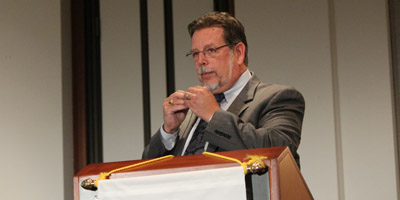SMPTE 2014: Aitken—Broadcast Must Be More Than TV

HOLLYWOOD—The “broadcast” in Sinclair Broadcast Group is morphing into something more than TV. It has to, according to Mark Aitken, SBG’s vice president of Advanced Technology. Aitken delivered a keynote at this year’s SMPTE conference in the heart of Hollywood.
“We don’t see ourselves simply as televisioners,” he said of SBG. “We see ourselves as having a platform to provide services, and one of those services is television.”
Aitken noted how the technical side of broadcasting is occupied with 4K, high-dynamic range, frame rates and so forth, while regulatory issues and business objectives are treated as entirely separate matters. Yet those very issues are determining the industry’s future, and they are legion, he said. Ownership limits, public inspection file rules, Aereo, the CALM Act, closed captioning, EAS, indecency, the incentive auction, tower and antenna issues, white spaces, the UHF discount… the list goes on.
“Engineers believe the technology is driving the business,” he said. “We as engineers are not taking a broad look at the surroundings in which we live, and taking the initiative to do the kinds of things to determine where broadcasting is going. …4K, HDR, immersive sound… we have all these beautiful potential entrapments of a consumer. But without understanding the business objective, there’s little to be gained.”
Aitken said broadcasters are in a state of war.
“War has been declared. Google has declared war on the TV ad industry. If your competitors believe they’re engaged in war with us; if we don’t acknowledge that, we’re going to lose. They are decidedly after what we’ve got… viewers, advertisers, content… they after making lots of money.
“You see a massive migration of content to the Internet; to the wireless industry. If you’re a content producer, you’re doing the right thing, looking for a distribution platform that generates the most revenue.
“I ask… why is it not a status quo that content isn’t coming to broadcasting? We exist as islands. We don’t function as an industry. The broadcast industry really has to unite, at least in a virtual sense. So what can we do to become a viable competitor in the marketplace?”
Ad dollars are leaving local broadcasting, he said, not at a rate where broadcasting will die in 10 years, but will be in bad shape.
“This is a reversible trend,” he said, but one that requires an immediate response. The wireless guys are ramping up LTE-broadcast. (See “Verizon’s Wireless Network ‘Ready’ for LTE Multicast”)
Phone companies’ appetite for TV is not entirely new. They’ve been after the business for years. Aitken recalled how, in 2007, he went to a poker game fundraiser held by the late Alaska senator, Ted Stevens.
“There were our or five tables. I was one of the last people to walk in. I got to my table, introduced myself. This young kid looked at me and said, ‘it’s great to have another broadcaster here.’ I said, ‘who do you work for?’ He said, ‘Verizon.’”
LTE-broadcast evolved without the type of standards constraints that hold back broadcasting, he said.
“Today, the standard does not have the flexibility to do multiple things, which is why we find ourselves developing ATSC 3.0. Broadcasters have been slow to the table to identify what their wants and needs are. The goal of many is the same as it was in 1994 when ATSC was being deployed. Those managers doing nothing but selling spots, who view revenues in a very small silo, don’t look at those opportunities because they don’t exist for them.”
One new opportunity looming large is the incentive auction. Sinclair and the National Association of Broadcasters are challenging the Federal Communications Commission’s Incentive Auction Report and Order on the grounds that it violates congressional intent.
“We believe broadcasting is being marched, quite literally, to the cliff,” he said.
The spectrum auction legislation contains the concept of “flex-use,” which is left #ff0000. For Sinclair, it opened the door to experiment with a new transmission standard. Sinclair subsidiary One Media is launching the group’s next-generation transmission platform in Austin, Texas, next month.
“As broadcasters, there’s a growing voice saying we need the same opportunity as wireless providers, instead of being locked into doing just one thing,” he said. “The challenge is thinking about what broadcasting could be.”
Sinclair’s answer—and it has been for years—is mobile. Particularly the mobile-connected tablet. Aitken called it “the consumptive device of the future.”
“In 1999, 2000, we worked with Nokia. We based the DVB-T standard on high-arc modulation. We had three tablets. They like several bricks bolted together. They were capable of receiving mobile television. This industry did not believe there was an opportunity in mobile 15 years ago.”
Tablet computers are now expected to generate more mobile data traffic in 2017 than the entire global mobile market in 2012.
When the Advanced Television Systems Committee did finally issue a mobile standard, it fell flat. Aitken more or less declared it dead.
“The failure of ATSC mobile was a failure on the part of not all broadcasters embracing it as an opportunity,” he said. “It was a massive failure because an industry did not put its will behind it. And because there was not a uniform roll-out, and no tough discussions with rights holders, consumers never had the opportunity to see it, and device makers never had the incentive to build devices.”
There is still an opportunity in mobile data offload, he said.
“There is real money in the broadcast distribution in data. There is a reason for LTE-broadcast. The ‘Internet of Things’ is all about the mass distribution of data to specific devices, measured today in billions of dollars. All of these devices are looking to take on more data. Broadcasting is a platform that could uniquely provide that,” he said. “It is clear, because of the consumption of video on mobile devices, that there is an overloading of networks. It’s not a spectrum issue. We could go to the base of what’s being consumed, pull out that data, and it could be broadcast.
“Solving the business, technical and political challenges to build the next-generation mobile video Internet, wired and wireless, is the greatest business opportunity in the broadcast, communications and media industry today,” he said. “But we need a business alignment among broadcasters that allow our assets to be seen as a service; the next-gen broadcast platform-as-a-service.”
“We have an opportunity, uniquely at this time, for broadcasting to reinvent itself. It’s not just about broadcast television, but as a purveyor of uniquely untold bits to all types of devices.”
The professional video industry's #1 source for news, trends and product and tech information. Sign up below.
